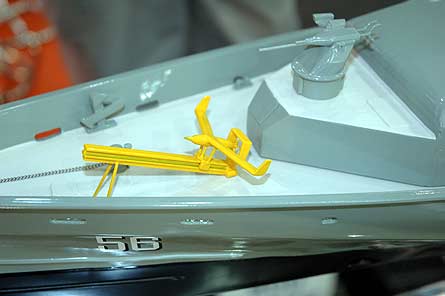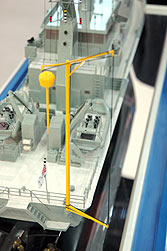Boeing Australia is negotiating with the Australian Department of Defence to stage a funded demonstration of a heavy-fuel-engine version of the Boeing-Insitu Scan Eagle UAV aboard a Royal Australian Navy Armidale class patrol boat during the second half of this year.
Henderson, Western Australia-based Austal Shipbuilding, which produces the Armidale class, is supporting integration planning and last week unveiled models of a modified Armidale boat at the IDEX 2007 exhibition in Abu Dhabi.
Austal business development manager Bill Hicks says that Boeing and Insitu teams have twice visited the shipbuilders yards, located south of Perth, in recent months to prepare detailed design work.
“We don’t see too many modifications needed to the system to support operations” he told Flight Unmanned at IDEX.
A catapult launcher will be fitted to the patrol boat foredeck, while Institu’s proprietary ‘skyhook’ recovery system recovery system will be mounted on the starboard aft deck. The datalink antenna will be fitted to a new mast that will be mounted between rear lower deck air intakes.

The UAV ground control station will be integrated into space provisions on the existing Armidale class bridge.
The planned flights will be the first from an RAN warship involving a tactical class UAV. It will also be the second UAV demonstration this year involving an Armidale class boat. Aerovironment flew its Aqua Puma water landing mini-UAV system off the type in January to support ongoing RAN planning for a potential acquisition.
The planned Scan Eagle demonstration will be funded by the Australian Defence Capability Executive, with that same organisation also funding the Aerovironment demonstration.
Insitu has previously fitted a Scan Eagle system to a small fishing boat to support demonstrations for commercial customers, however the planned Armidale class trial will represent the smallest military vessel yet modified to operate that UAV type.

The Australian Army last year signed service contracts with Boeing Australia to provide Scan Eagle systems to support forces deployed in Iraq through until June this year. “The ADF is already using the system and we don’t want to reinvent the wheel for the Armidale solution” Hicks says.
However he also says integration of other UAV types aboard the class is possible depending on eventual RAN requirements. “We have no particular bias for a system bar it being proven rather than prototyping,” he notes.
Austal Shipbuilding last year proposed development of a small flight deck for the back of the Armidale class to facilitate operation of the Schiebel S-100 vertical take off and landing UAV and had sought RAN interest in a demonstration programme.
Hicks says that while extended discussions with Schiebel indicated S-100 operations were feasible, that UAV type was assessed by Austal and the RAN as needing more development to allow take-offs and landings on a moving platform. “Its precision landing isn’t quite robust enough yet, he explains.
The RAN had also expressed concerns about the fuel used by the S-100 Hicks said, with the service having a policy of not allowing petrol aboard its ships.
Austal and Boeing Australia are also exploring a potential demonstration of Scan Eagle in cooperation with Bay Class patrol boats it has built for the Australian Customs Service. Those vessels are similar in configuration to the Armidale Class but smaller in length and the most likely approach would be to launch the UAV from the shore but control it from the Bay Class bridge for the duration of it mission time.
Source: FlightGlobal.com























